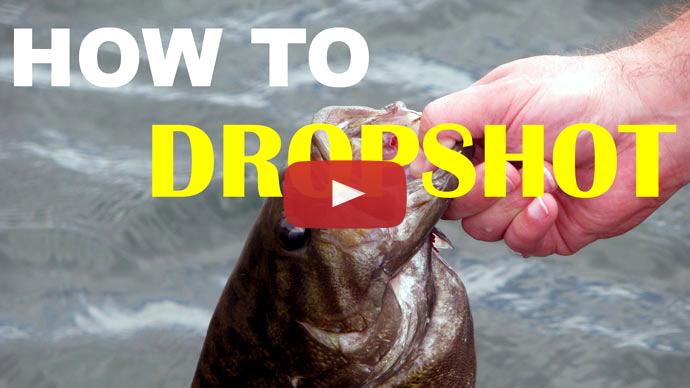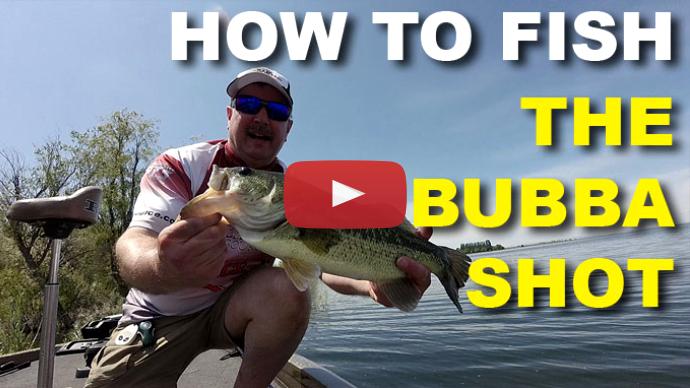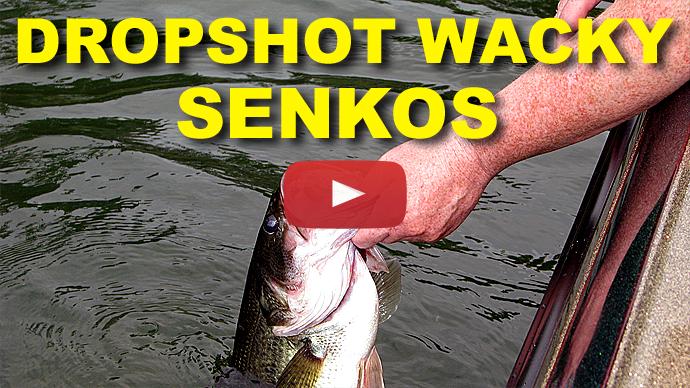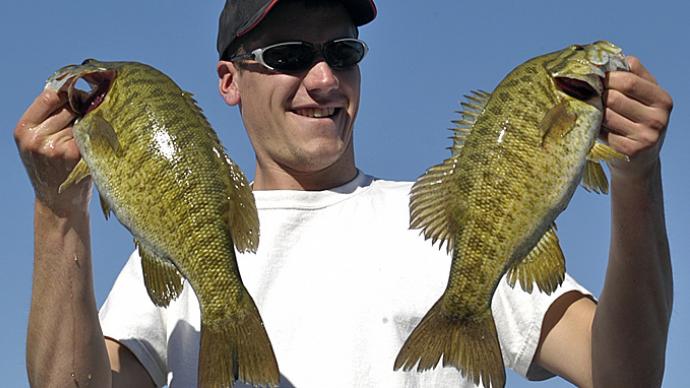Keri: What are your three tips for drop shotting?
Edwin Evers: Well, my first tip is, it's a bait I always have tied on, and I think a lot of people don't realize that. It's not just a bait for deep, vertical, fishing, it's a bait that I have tied on all the time. The second tip is, with that being said, well, if I'm fishing a drop shot I'm going to have a shallow, I'm going to have a very light weight, you know, a 1/8-ounce being the biggest if I'm casting it to shallow targets. When I'm fishing at vertical, that's when I have a big weight. So, you know, adjust the size of the weight, depending on the depth that you're fishing, bigger weight vertical, lighter casting it horizontal. And, then, the third tip is probably my leader length. The shallower I'm fishing, the shorter that leader length is and I'm talking about between the worm weight and the weight, or the bait and the weight, and the deeper I'm fishing it, the further away I have that, so, that should help you a little bit.
Keri: That does help a lot. Thank you so much.
Greg Hackney: Probably the number one tip on drop shotting is be versatile with your leader length. You know, there are certain times when, you know, you don't want your leader over 4 inches and there are other times when you want your bait 4 feet. You know, a lot of times it's, you know, seeing how the fish are positioned. Are they suspended off the bottom, are they on the bottom? Typically, any time I'm pitching a drop shot to a target I always have a tendency to use a smaller, you know, length between my hook and my weight. And the reason for that is, a lot of times you're pitching cypress trees, or laydowns, or stuff like that, the fish are close to the bottom, so you want your worm down there close to the bottom.
Number two would be don't limit it to a spinning rod. You know, one of the best techniques ever is actually flipping a drop shot on bigger tackle in the same place as you would typically fish a Texas rig, or a jig, or, and it's the finesse version of a Texas rig, basically is what it is. You're able to get that bait in there with a weight, but the bait is weightless, so, it gives you the best of both worlds.
Probably the last tip would be, anytime I'm fishing a drop shot I'm always using a leader. And I typically don't use, like, straight fluoro, and the reason for that, it'll have a tendency to spin your line, or cause your line to kink, if you use straight fluoro. And if you use the fluorocarbon tied to a braid, my mainline being a braid, regardless if I'm flipping it on a casting rod or a spinning rod, that just takes out line twist.
Jacob Wheeler: Drop shots are something that's caught them for a long, long time, I mean, Aaron Martens and Guido Hibdon and those guys have started...you know, finesse fishing's been very popular. I would say, if you're having issues, go out there on the water and you're saying, okay, well, you know, starting with trying to figure out what color worm you need though. You know, you see guys throwing pink, you see guys throwing green pumpkins, keep it simple, you know, I only have three different colors I throw out there. There's green pumpkin, I will throw more of, like, a morning dawn and then I'll throw a black, a straight black. I've actually caught a lot of fish on black, a black worm shape, you know, when I'm drop shotting. If I'm fishing for small-mouth, they love black for some reason, they can see it in that clear water and something that those fish can...you know, that silhouette that bait, and go over there and eat it.
Hook choice, that's a huge ordeal. When I'm fishing a Wacky style worm on a drop shot, my favorite hook to use is a size 4, VMC Neko hook. And what that is, you have a little bit larger barb, little bit bigger gap. And you want to have a little bit more meat there, because when that fish grabs a straight shank hook, or like a rebarb, something like that, those fish are gonna get a lot better. You're gonna hook them, you gonna land. Hook-to-land ratio's gonna be a lot, lot, lot better. And, then, also light weights, I see a lot of people, obviously they think drop shot, they think deep water. I've caught a lot of big fish in super shallow water on a 1/8-ounce drop shot. So, don't be afraid to lighten your weight up and try that.
Ott DeFoe: Drop shotting, the first tip would be to ask somebody else that's a lot better at it than I am. But, I do it some, and catch a lot of fish doing it at times. And biggest thing, I would say is, on your hook set, don't just reel into them. You know, I mean, you're using a light line, a small diameter hook. I like that VMC Neko hook for my drop shot fishing. And you don't have to set the hook, you just start reeling and you've got him, you know, so, that's one thing that's really nice about it.
Keri: It's very difficult?
Ott DeFoe: Yeah, it can be. I like to set the hook, but, you know, you just don't have to with that. Another would be, you know, to use different leader lengths. There's scenarios where a real short leader is better, and scenarios where a 2-foot leader's better, so, play around with that some and then ask Aaron Martens what to do.
Keri: And ask Aaron Martens, yeah.
Ott DeFoe: Those are my three tips.
Keri: Remember that folks, ask Aaron Martens what to do.
Ott DeFoe: Yep, absolutely.
Skeet Reese: Best three tips for drop shotting? For me, now, it's my new thing I'm excited about and I've been fishing the last two years, it's an 8 1/2-foot spinning rod. People can't comprehend that, but I have a new 8 1/2-foot rod. It's my new favorite spinning rod, period. It's a really soft-action tip, I can fish 6-pound test on it, or I can fish 20-pound test on it. But the way the rod tip shakes is different than any other rod, so I get a lot more action out of the worm. But I'm able to cast it further and typically, the further you get a bait away from a boat, the more bites you're gonna get. And it allows me to get a much better hook set than a 6 1/2- or 7-foot rod. The hook sets, it's dramatically different. And, I fish NanoFil to a fluorocarbon leader, so you get the sensitivity, the feel.
That would be the tip number two, is use a braided line. For me it's NanoFil because it casts further. But, then, going to a fluorocarbon leader so you get the sensitivity and feel of that... And then third...wow, third one.
Keri: The third one.
Skeet Reese: Third one. Still the same deal, typically, the lighter the weight, because a lot of times...I'm a firm believer you'll catch more fish on a drop shot when the bait's on a fall, than you do actually working on the bottom. So, a lighter bait weight gives a slower fall. It will help you get more bites.
Keri: All right, top three tips for drop shotting.
Brandon Palaniuk: Top three tops for drop shotting? I would say the first thing is, I prefer a braided line to a fluorocarbon leader. And the reason for that is, the braid is going to allow you to throw a heavier pound test. So, I'll throw a 15-pound Seaguar Smackdown braid, and it's the diameter of 6-pound test, so on a spinning reel I can get a lot more line on there. And it also allows me to cast without the line just exploding off my reel, because it has a lot less memory. It's not going to be all coiled up, which is nice on a spinning reel. And, then, the fluorocarbon leader is going to, you know, be clear in the water, it's going to present the bait a lot better, and help with abrasion resistance. And, the next thing would be, probably, selecting the bait, right? A lot of these theories are the same...
Keri: Are the same for each one.
Brandon Palaniuk: ...across the board, because, a drop shot, you can select lots of different baits. If I'm up north chasing small-mouth, a lot of times I'm choosing 3-, 4-inch-style baits, like a Zoom Z drop or something. When I go down south, a lot of times I'll still drop shot and I'll fish around grass, maybe bigger fish, then I'll go to, like, a Zoom trick worm, or even a Magnum trick worm. So, I've got a little bit bigger profile for those bigger fish, I'll actually rig it Texas rigged, on a drop shot, so that it's weedless, I can fish it around cover. And then, I would say the next thing there would probably be, again, selecting your weight size, because a lot of times the rate of fall will trigger those fish. Especially if you're in clear water, those fish see it coming from a long ways away, and just the rate of fall when those see it can determine whether or not they bite it when it actually hits the bottom.
Keri: Now, do weather conditions also apply too? If it's really windy, you, know, if you're going to be drop shotting?
Brandon Palaniuk: Definitely, you're gonna have to up your weight. And, typically for me, selecting weights, if I'm less than 10-foot, I'll try to go with an 1/8. 10 to 20 I go to about a 1/4, and then 3/8, down to about 30- or 40-foot. And, then, if it's windy you have to up those weights, even in the shallower depths.
Keri: What are your top three tips for drop shotting?
Brent Ehrler: Top three tips? I use two baits, a Roboworm, or a metal thin Senko. The Roboworm I'm gonna do Texas rig, or with a nose hook. With a thin Senko I'm gonna do Wacky rig, and I use both those on a drop shot. They have different actions to them, you know, the Wacky rig you can let flutter down and fall, and it falls like a Senko, and then you can lift it and shake it again. The biggest tip that I can give, and this is one that I'm really gonna stress and we're gonna lead with this, is lots of movement with the bait, and not movement with the weight. So, if you think about a drop shot, the weight's on the bottom, the worm's above, so you want to move that worm without moving the weight, meaning that you can leave that bait in the strike zone. So, if you're casting, or if you're dropping, it doesn't matter, you can impart action onto that bait without ever moving the weight or moving the bait away from the fish. You can keep it in their face for a long time and that's the biggest trick with a drop shot.
Keri: Perfect, thank you, and great tips.




